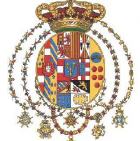The supporters of Prince Ferdinando and his son have recently presented an Internet web site, entitled http://www.twosicilies.org intended to promote their cause. This makes various statements concerning the pretensions of the junior line to the Headship of the Royal House and the Grand Magistery of the Constantinian Order and the Two Sicilies royal Orders.
Unfortunately, the authors of this site, with the total lack of respect for the facts demonstrated so often by the supporters of Prince Ferdinando and his son, Prince Carlo, have made some astonishing and completely false claims. They do not refer to the various forged documents published by supporters of Prince Ferdinando in the past to justify their case, but they make statements concerning various decrees that have no foundation.
For example, they state:
The Grand Magistry of the Sacred Military Constantinian Order of Saint George is attached to the headship of the Royal House of Bourbon of the Two Sicilies, from which it cannot be separated unless the dynasty itself becomes extinct. (During the Bourbon reign, the foremost Neapolitan legal scholars and jurists, such as Raffaele Ruo, wrote extensively and officially on this topic, basing their observations on royal decrees and actual practice.)
This statement is false and of course no specific royal decree is cited to support it. As can be easily demonstrated, the precise opposite was true, the two dignities were entirely separate. The last official decree issued during the Monarchy was published by King Ferdinand IV and III (later I of the Kingdom of the Two Sicilies) on 8 March 1796, in a Royal dispatch, added as an appendix to the Statutes: "Avere (Avendo) il Re ponderatamente preso nella dovuta considerazione che nella sua Sacra Real Persona concorrono due ben distinte qualità, l'una di Monarca delle due Sicilie, e l'altra di Gran Maestro dell'inclito, reale e militare ordine costantiniano, le quali benchè gloriosamente si uniscono in se stesso, formano nondimeno le medesime due diverse Signorie indipendenti, e per le leggi, e per le prerogative, e per i privilegi, e sopratutto per la giurisdizione; tanto che i predecessorin Gran Maestri di tal ordine han formato un Codice di Costituzioni denominato statuti, nei quali si scorge l'espressa volontà di stabilire una giurisdizione privativa, e per l'Ordine istesso, e pei Cavalieri ed individui, eligendo a tale effetto un Supremo Magistral Consiglio per la cognizione di tutti i diritti, prerogative e cause, che se le appartengono ........... quindi è che la M.S., per ovviare in avvenire simili abusi, e considerando le sue prerogative, come Gran Maestro". The text of this decree and other decrees emphasizing the separation of the two charges may be read here Part III, A-W.
The authors of this essay also claim:
"Before King Carlo departed Naples to assume the Spanish Throne in 1759, he abdicated the Crowns of Naples and Sicily in favor of his third-born son, Ferdinando. At that time, he issued a Pragmatic declaring that henceforth any prince entitled to a place in the Spanish succession could not simultaneously claim the Crown of the Two Sicilies or a place in the succession to that Crown. (This law served to forever separate the dynasty of the Two Sicilies from that of Spain.) On several occasions --most recently in 1900-- princes have renounced their rights of succession for themselves and any eventual heirs in compliance with this law."
The falsity of this statement may be demonstrated by review of the documents linked below, particularly the complete text of the Pragmatic Decree of 1759. It is also false to state that any Prince or Princess of the Two Sicilies renounced or attempted to renounce the succession before the illegal act of Cannes of 1900. The only Princes of the Two Sicilies to marry Infantas of Spain after 1759 were Francis I, who did not renounce, and nor did his wife the Infanta Isabel, and his grandson the Count of Girgenti, who in 1868 married the heiress presumptive to the Spanish Crown. A renunciation was drawn up for his signature should his wife succeed to the Spanish throne (and this is conserved, unsigned, in the family archives), but he committed suicide in 1871 and she never succeeded in any case. Several Princesses of the Two Sicilies, each of whom were eligible for the succession in the event of the extinction of the male line, married Kings or Infants of Spain, with no requirement to renounce.
The wholly invented claims concerning the scope of the famous Pragmatic Decree of 1759, drawn up by King Charles VII of Naples, III of Spain, to regulate the succession to the Crown of the Two Sicilies, are easily disproved. This important act is the fundamental succession law to the Two Sicilies Crown and was reinforced in the Constitution of 1860 by Francis II shortly before he was forced to flee to Gaeta. It therefore remains the continuing and legally binding succession law of the Kingdom.
Its sole purpose, as stated clearly in the preamble, was to prevent the union of the Spanish and Two Sicilies Crowns. This was requried by the terms of the Treaty of Vienna of 1738 and the Treaty of Naples of 3 Oct 1759. It provides that should the King of Spain or his immediate heir, the Prince of the Asturias, inherit the Two Sicilies Crown, they should abicate the latter to the next male heir in line.
King Charles also laid out the order of succession to the Crown. His eldest son, who predeceased him, was mentally retarded, so he named his second son, Carlos, to be his successor as King of Spain, with the title Prince of the Asturias. His third son, Ferdinand, was established immediately as King of the Two Sicilies, although he did not cede to him the Grand Magistery of the Order of Saint Januarius which he retained until 1766, and still maintained his interest in the administration of the Constantinian Order. The Grand Magistery of this Order was ceded to Ferdinand in a separate act, naming him "primogenito leggitimo farnesiano" ten days after the Pragmatic Decree.
The Pragmatic Decree also declares that after Ferdinando, or failing his heirs, the throne should pass to each of his younger sons, Infants of Spain, in turn, and failing their male heirs to the nearest female heiress of the last male. Only failing them would the Crown pass to the descendants of his brothers, the Duke of Parma and Infante don Luis. The essential point is that all his descendants were eligibile for both the Crowns of Spain and the Two Sicilies.
This was made clear in the protests against the repeal of Salic Law by King Ferdinand VII of Spain, made by the Neapolitan Ambassador in Madrid in March 1830, shortly thereafter by King Francis I in 1830, by the Neapolitan Charge d'Affaires in Madrid later that year, and the official protest, leading to an eleven year break in diplomatic relations, by King Ferdinand II in 1833. This act of FerdinandVII significantly diminished the rights of the Two Sicilies line to the Spanish throne by the introduction of female as well as male descendants into the Spanish succession. Had the Kings of the Two Sicilies not enjoyed a right of succession to Spain, these protests would have been unnecessary. Unfortunately, the authors of the so-called "official site" of the "twosicilies.org" are unconcerned with the facts, but have proposed a wholly invented hypothesis, that it is allegedly impossible to be a Spanish and Two Sicilies dynast at one time. They claim as authority for this statement the Pragmatic Decree of 1759, whose full text is given here. By not quoting either part or the entirety of any of the documents to which they refer as "authority" for their statements, they presumably intend to mislead any reader of the information given on their site.
These documents (available at the links given here) are clear, emphatic and unambiguous.





